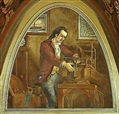The Steam-Powered Canoe
1786
by John Rich
Who invented the steam boat? Ask most people that question and the conventional wisdom answer is "Robert Fulton". And that brings up images in your mind of giant paddlewheel steamers plying the waters of America's rivers.
But America's first steamboat was actually invented by a man named John Fitch. And instead of paddlewheels, his boats were driven by Indian canoe paddles.
 |
|
 |
|
 |
|
 |
John Fitch
(1743-1798) |
|
John Fitch, fresco in
the U.S. Capitol,
Washington, D.C. |
|
John Fitch |
|
John Fitch,
American inventor |
John Fitch had served in the Revolutionary War and had seen many Indian canoes being paddled by multiple Indians in synchronization with each other. He came to realize the potential importance to commerce of boat traffic on rivers in America for the coming Industrial Revolution, and the need for powerboats to move upstream or downstream at will, independent of weather, currents and tides.
His boat design was inspired by the sight years earlier of a canoe full of Indian warriors racing through the water. And so his natural inclination was to use the newly invented steam engine to reproduce the movements of those Indian paddlers using canoe paddles.
Fitch discussed his plans with many potential investors, including Benjamin Franklin and George Washington, but was unable to secure investment in his steamboat. Even after Fitch built his first steamboat in 1787 and took Constitutional Convention delegates on a boat ride on the Delaware River, support was not forthcoming. So Fitch scraped together private funding to finance his venture.
Another problem was that Britain had prohibited the importation of the new steam engine technology to America. But Fitch, undaunted, built his own steam engine from scratch. He combined the features of several different styles of steam engines, and overcoming many mistakes, developed one that was small and light enough to be mounted on a boat. Then it was just a matter of creating the mechanical linkage from the steam engine to drive the paddles.
It was an odd machine, propelled by twin racks of Indian-canoe paddles, six on each side of the boat, twelve paddles in total. At any one time, three paddles on each side would be performing a draw stroke for propulsion, while the other three paddles on that side were being lifted and returned to the forward position in preparation for the next draw stroke. Thus, there was little or no pause between strokes, providing continuous forward propulsion.
 |
|
 |
Fitch's Indian paddle
canoe steamboat design |
|
Fitch's 1787 Philadelphia
steamboat, featuring his
crank and paddle design |
By the summer of 1790, Fitch used it in a successful passenger line, offering three round-trips per week between Philadelphia, Pennsylvania, and Trenton, New Jersey. He logged thousands of miles at six to eight mph carrying passengers that summer. Estimates of miles traveled that summer range from 1,300 to 3,000 miles, and Fitch claimed that the boat often went for 500 miles without mechanical problems. But it failed commercially - people wouldn't take it seriously. All they saw was a curiosity - a stunt.
Fitch had demonstrated that steamboat travel was viable. Future innovators like Robert Fulton, with better financial, political and patent backing, two decades later, would make Fitch's vision of steamboats plying American waterways a reality.
Here is a video of a scale model built using Fitch's design, showing the mechanics in action:
Of course, neither one could do a J-stroke, a draw or a pry...
 |
| The author, John Rich |